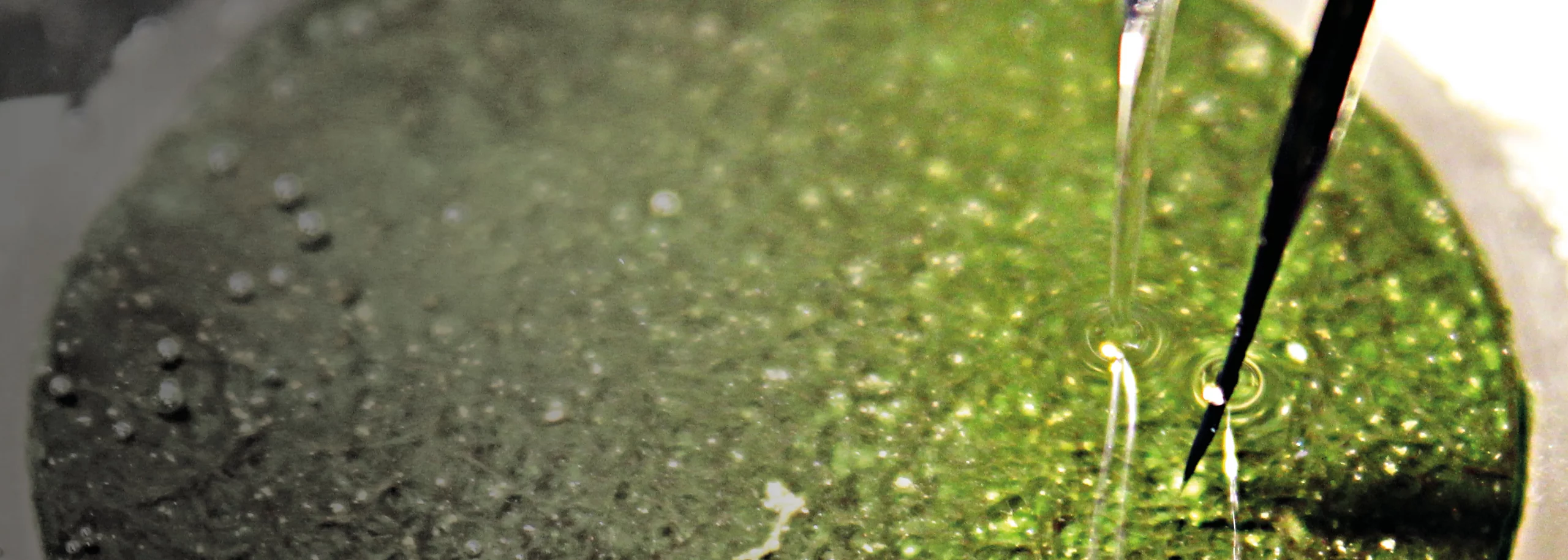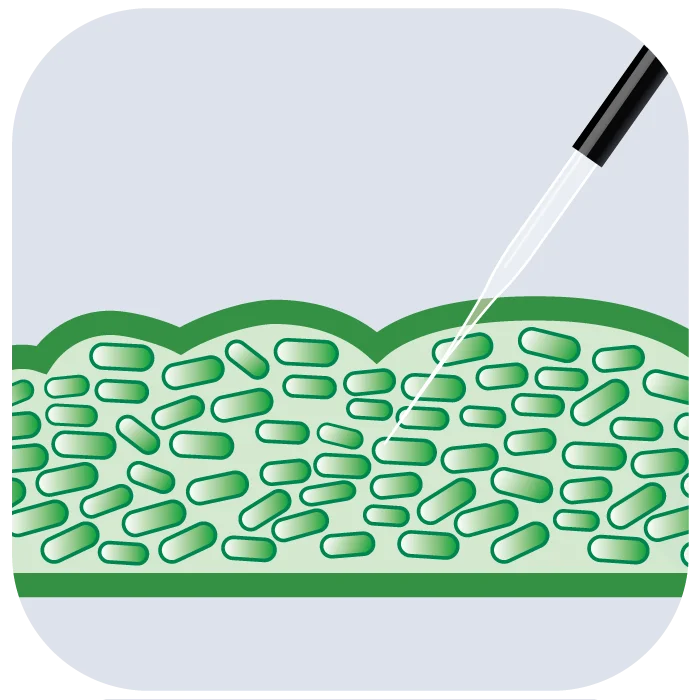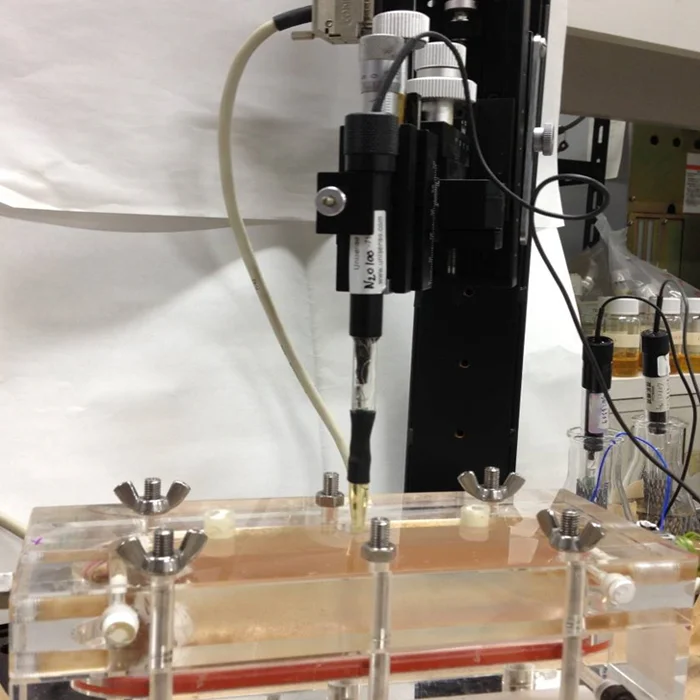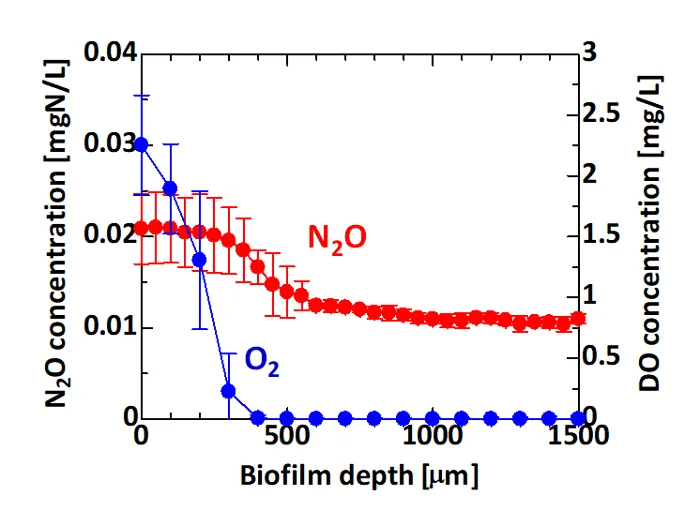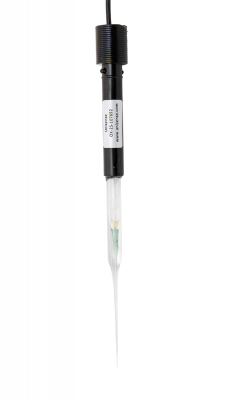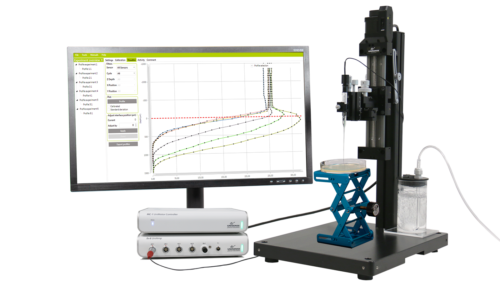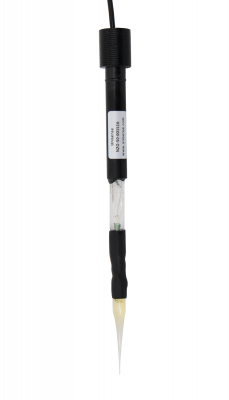Immobilization of Azospira sp. strain I13 by gel entrapment for mitigation of N2O from biological wastewa…
Suenaga, Toshikazu et al. (2018),
Journal of Bioscience and Bioengineering,
vol. 126,
213-219
Suenaga, Toshikazu, Aoyagi, Ryo, Sakamoto, Nozomi, Riya, Shohei, Ohashi, Hidenori, Hosomi, Masaaki, Tokuyama, Hideaki, Terada, Akihiko (2018),
Journal of Bioscience and Bioengineering,
vol.
126,
213-219
Development of a strategy to mitigate nitrous oxide (N2O) emitted from biological sources is important in the nexus of wastewater treatment and greenhouse gas emission. To this end, immobilization of N2O-reducing bacteria as a biofilm has the potential to ameliorate oxygen (O2) inhibition of the metabolic activity of the bacteria. We demonstrated the effectiveness of calcium alginate gel entrapment of the nosZ clade II type N2O-reducing bacterium, Azospira sp. strain I13, in reducing levels of N2O, irrespective of the presence of O2. Azospira sp. strain I13 cells in the gel exhibited N2O reduction up to a maximum dissolved oxygen concentration of 100 μM in the bulk liquid. The maximum apparent N2O uptake rate, Vm,N2O′, by gel immobilization did not appreciably decrease, retaining 72% of the N2O reduction rate of the cell suspension of Azospira sp. strain I13. Whereas gel immobilization increased the apparent half-saturation constant for N2O, Km,N2O′, and the apparent O2 inhibition constant, KI,O2′, representing the degree of O2 resistance, correspondingly increased. A mechanistic model introducing diffusion and the reactions of N2O consumption was used to describe the experimental observations. Incorporating Thieles modulus into the model determined an appropriate gel size to achieve N2O reduction even under aerobic conditions.
10.1016/j.jbiosc.2018.02.014
Nitritation performance in membrane-aerated biofilm reactors differs from conventional biofilm systems
Lackner, Susanne et al. (2010),
Water Research,
vol. 44,
6073-6084
Lackner, Susanne, Terada, Akihiko, Horn, Harald, Henze, Mogens, Smets, Barth F. (2010),
Water Research,
vol.
44,
6073-6084
Nitrogen removal via nitrite has gained increasing attention in recent years due to its potential cost savings. Membrane-aerated biofilm reactors (MABRs) are one potential technology suitable to achieve nitritation. In this study we compared lab scale MABRs with conventional biofilm reactors to evaluate the influence of environmental conditions and operational parameters on nitritation performance. The oxygen mass transfer rate is postulated as a crucial parameter to control nitritation in the MABR: Clean water measurements showed significant underestimation of the total oxygen mass transfer, however, accurate determination of the oxygen mass transfer coefficient (km) of the system could be achieved by adjusting the liquid-phase mass transfer resistance in the constructed model. Batch experiments at different initial ammonium concentrations revealed that the conventional biofilm geometry was superior for nitritation compared to MABRs. These differences were reflected well in estimates of the oxygen affinity constants of the key microbial players, AOB and NOB (KO,AOB < KO,NOB (in both systems) and KO,NOB values smaller in the MABR vs. the conventional biofilm system). It also appeared that - in addition to oxygen limitation - the absolute and relative substrate concentrations in the biofilm (esp. of oxygen) are very important for successful nitritation. Initial biomass composition, furthermore, impacted reactor performance in the MABR systems indicating the need for appropriate inoculum choice. © 2010 Elsevier Ltd.
10.1016/j.watres.2010.07.074
Enrichment, Isolation, and Characterization of High-Affinity N2O-Reducing Bacteria in a Gas-Permeable Membrane Reactor
Suenaga, Toshikazu et al. (2019),
Environmental Science and Technology,
vol. 53,
12101-12112
Suenaga, Toshikazu, Hori, Tomoyuki, Riya, Shohei, Hosomi, Masaaki, Smets, Barth F., Terada, Akihiko (2019),
Environmental Science and Technology,
vol.
53,
12101-12112
The recent discovery of nitrous oxide (N2O)-reducing bacteria suggests a potential biological sink for the potent greenhouse gas N2O. For an application toward N2O mitigation, characterization of more isolates will be required. Here, we describe the successful enrichment and isolation of high-affinity N2O-reducing bacteria using a N2O-fed reactor (N2OFR). Two N2OFRs, where N2O was continuously and directly supplied as the sole electron acceptor to a biofilm grown on a gas-permeable membrane, were operated with acetate or a mixture of peptone-based organic substrates as an electron donor. In parallel, a NO3- -fed reactor (NO3FR), filled with a nonwoven sheet substratum, was operated using the same inoculum. We hypothesized that supplying N2O vs NO3- would enhance the dominance of distinct N2O-reducing bacteria. Clade II type nosZ bacteria became rapidly enriched over clade I type nosZ bacteria in the N2OFRs, whereas the opposite held in the NO3FR. High-throughput sequencing of 16S rRNA gene amplicons revealed the dominance of Rhodocyclaceae in the N2OFRs. Strains of the Azospira and Dechloromonas genera, canonical denitrifiers harboring clade II type nosZ, were isolated with high frequency from the N2OFRs (132 out of 152 isolates). The isolates from the N2OFR demonstrated higher N2O uptake rates (Vmax: 4.23 × 10-3-1.80 × 10-2 pmol/h/cell) and lower N2O half-saturation coefficients (Km,N2O: 1.55-2.10 μM) than a clade I type nosZ isolate from the NO3FR. Furthermore, the clade II type nosZ isolates had higher specific growth rates on N2O than nitrite as an electron acceptor. Hence, continuously and exclusively supplying N2O in an N2OFR allows the enrichment and isolation of high-affinity N2O-reducing strains, which may be used as N2O sinks in bioaugmentation efforts.
10.1021/acs.est.9b02237
New insight into CO2-mediated denitrification process in H2-based membrane biofilm reactor: An experiment…
Jiang, Minmin et al. (2020),
Water Research,
vol. 184,
116177
Jiang, Minmin, Zheng, Junjian, Perez-calleja, Patricia, Picioreanu, Cristian, Lin, Hua, Zhang, Xuehong, Zhang, Yuanyuan, Li, Haixiang, Nerenberg, Robert (2020),
Water Research,
vol.
184,
116177
The H2-based membrane biofilm reactor (H2−MBfR) is an emerging technology for removal of nitrate (NO3−) in water supplies. In this research, a lab-scale H2−MBfR equipped with a separated CO2 providing system and a microsensor measuring unit was developed for NO3− removal from synthetic groundwater. Experimental results show that efficient NO3− reduction with a flux of 1.46 g/(m2⋅d) was achieved at the optimal operating conditions of hydraulic retention time (HRT) 80 min, influent NO3− concentration 20 mg N/L, H2 pressure 5 psig and CO2 addition 50 mg/L. Given the complex counter-diffusion of substrates in the H2−MBfR, mathematical modeling is a key tool to both understand its behavior and optimize its performance. A sophisticated model was successfully established, calibrated and validated via comparing the measured and simulated system performance and/or substrate gradients within biofilm. Model results indicate that i) even under the optimal operating conditions, denitrifying bacteria (DNB) in the interior and exterior of biofilm suffered low growth rate, attributed to CO2 and H2 limitation, respectively; ii) appropriate operating parameters are essential to maintaining high activity of DNB in the biofilm; iii) CO2 concentration was the decisive factor which matters its dominant role in mediating hydrogenotrophic denitrification process; iv) the predicted optimum biofilm thickness was 650 µm that can maximize the denitrification flux and prevent loss of H2.
10.1016/j.watres.2020.116177
Combination of15N Tracer and Microbial Analyses Discloses N2O Sink Potential of the Anammox Community
Suenaga, Toshikazu et al. (2021),
Environmental Science and Technology,
vol. 55,
9231-9242
Suenaga, Toshikazu, Ota, Takumi, Oba, Kohei, Usui, Kentaro, Sako, Toshiki, Hori, Tomoyuki, Riya, Shohei, Hosomi, Masaaki, Chandran, Kartik, Lackner, Susanne, Smets, Barth F., Terada, Akihiko (2021),
Environmental Science and Technology,
vol.
55,
9231-9242
Although nitrogen removal by partial nitritation and anammox is more cost-effective than conventional nitrification and denitrification, one downside is the production and accumulation of nitrous oxide (N2O). The potential exploitation of N2O-reducing bacteria, which are resident members of anammox microbial communities, for N2O mitigation would require more knowledge of their ecophysiology. This study investigated the phylogeny of resident N2O-reducing bacteria in an anammox microbial community and quantified individually the processes of N2O production and N2O consumption. An up-flow column-bed anammox reactor, fed with NH4+and NO2-and devoid of oxygen, emitted N2O at an average conversion ratio (produced N2O: influent nitrogen) of 0.284%. Transcriptionally active and highly abundantnosZgenes in the reactor biomass belonged to theBurkholderiaceae(clade I type) andChloroflexusgenera (clade II type). Meanwhile, less abundant but actively transcribingnosZstrains were detected in the generaRhodoferax,Azospirillum,Lautropia, andBdellovibrioand likely act as an N2O sink. A novel15N tracer method was adapted to individually quantify N2O production and N2O consumption rates. The estimated true N2O production rate and true N2O consumption rate were 3.98 ± 0.15 and 3.03 ± 0.18 mgN·gVSS-1·day-1, respectively. The N2O consumption rate could be increased by 51% (4.57 ± 0.51 mgN·gVSS-1·day-1) with elevated N2O concentrations but kept comparable irrespective of the presence or absence of NO2-. Collectively, the approach allowed the quantification of N2O-reducing activity and the identification of transcriptionally active N2O reducers that may constitute as an N2O sink in anammox-based processes.
10.1021/acs.est.1c00674
Organic carbon determines nitrous oxide consumption activity of clade I and II nosZ bacteria: Genomic and…
Qi, Chuang et al. (2022),
Water Research,
vol. 209,
117910
Qi, Chuang, Zhou, Yiwen, Suenaga, Toshikazu, Oba, Kohei, Lu, Jilai, Wang, Guoxiang, Zhang, Limin, Yoon, Sukhwan, Terada, Akihiko (2022),
Water Research,
vol.
209,
117910
Harnessing nitrous oxide (N2O)-reducing bacteria is a promising strategy to reduce the N2O footprint of engineered systems. Applying a preferred organic carbon source as an electron donor accelerates N2O consumption by these bacteria. However, their N2O consumption potential and activity when fed different organic carbon species remain unclear. Here, we systematically compared the effects of various organic carbon sources on the activity of N2O-reducing bacteria via investigation of their biokinetic properties and genomic potentials. Five organic carbon sources—acetate, succinate, glycerol, ethanol, and methanol—were fed to four N2O-reducing bacteria harboring either clade I or clade II nosZ gene. Respirometric analyses were performed with four N2O-reducing bacterial strains, identifying distinct shifts in DO- and N2O-consumption biokinetics in response to the different feeding schemes. Regardless of the N2O-reducing bacteria, higher N2O consumption rates, accompanied by higher biomass yields, were obtained with acetate and succinate. The biomass yield (15.45 ± 1.07 mg-biomass mmol-N2O−1) of Azospira sp. strain I13 (clade II nosZ) observed under acetate-fed condition was significantly higher than those of Paracoccus denitrificans and Pseudomonas stutzeri, exhibiting greater metabolic efficiency. However, the spectrum of the organic carbon species utilizable to Azospira sp. strain I13 was limited, as demonstrated by the highly variable N2O consumption rates observed with different substrates. The potential to metabolize the supplemented carbon sources was investigated by genomic analysis, the results of which corroborated the N2O consumption biokinetics results. Moreover, electron donor selection had a substantial impact on how N2O consumption activities were recovered after oxygen exposure. Collectively, our findings highlight the importance of choosing appropriate electron donor additives for increasing the N2O sink capability of biological nitrogen removal systems.
10.1016/j.watres.2021.117910
